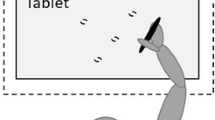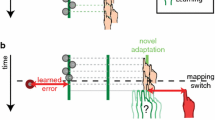Abstract
The goal of the present study was to determine whether learning of a manual video-aiming task that would have to be performed in a target-only condition (transfer test) would be improved, unaffected or hindered by alternating practice between a normal vision and a target-only condition. The results of the present study indicate that a mixed schedule of practice hindered learning of the task. Specifically, participants who practiced the task in the mixed schedule showed larger direction constant error in transfer than participants who practiced only in the target-only condition. The results suggest that participants in the mixed condition continued to rely on the rapidly decaying information that was extracted in the normal vision condition to plan and control their movement in the target-only condition, which ultimately led to biased movement endpoints.











Similar content being viewed by others
References
Abahnini K, Proteau L (1999) The role of peripheral and central visual information for the directional control of manual aiming movements. Can J Exp Psychol 53:160–175
Bédard P, Proteau L (2003) On the role of peripheral visual afferent information for the control of rapid video-aiming movements. Acta Psychol 113:90–117
Bédard P, Proteau L (2001) On the role of static and dynamic visual afferent information in goal-directed aiming movements. Exp Brain Res 138:419–431
Desmurget M, Epstein CM, Turner RS, Prablanc C, Alexander GE, Grafton SE (1999) Role of posterior parietal cortex in updating reaching movements to a visual target. Nature Neurosci 2:563–567
Desmurget M, Grafton SE (2000) Forward modeling allows feedback control for fast reaching movements. Trends Cogn Sci 4:423–431
Desmurget M, Rossetti Y, Prablanc C, Stelmach GE, Jeannerod M (1995) Representation of hand position prior to movement and motor variability. Can J Physiol Pharmacol 73:262–272
Desmurget M, Vindras P, Gréa H, Viviani P, Grafton ST (2000) Proprioception does not quickly drift during visual occlusion. Exp Brain Res 134:367–377
Fitts PM (1954) The information capacity of the human motor system in controlling the amplitude of movement. J Exp Psychol 47:381–391
Goodale MA, Pélisson D, Prablanc C (1986) Large adjustments in visually guided reaching do not depend on vision of the hand or perception of target displacement. Nature 320:748–750
Gordon J, Ghilardi MF, Cooper SE, Ghez C (1994) Accuracy of planar reaching movements. II Systematic extent errors resulting from inertial anisotropy. Exp Brain Res 99:112–130
Khan MA, Elliott D, Coull J, Chua R, Lyons J (2002) Optimal control strategies under different feedback schedules: kinematic evidences. J Motor Behav 34:45–58
Khan MA, Franks IM, Goodman D (1998) The effect of practice on the control of rapid aiming movements: evidence for an interdependency between programming and feedback processing. Q J Exp Psychol A 51:425–444
Krakauer JW, Pine ZW, Ghilardi MF, Ghez C (2000) Learning of visuomotor transformations for vectorial planning of reaching trajectories. J Neurosci 20:8916–8924
Lhuisset L, Proteau L (2002) Developmental aspects of the control of manual aiming movements in aligned and non-aligned visual displays. Exp Brain Res 146:293–306
Meyer DE, Abrams RA, Kornblum S, Wright CE, Smith JE (1988) Optimality in human motor performance: ideal control of rapid aimed movements. Psychol Rev 95:340–370
Prablanc C, Martin O (1992) Automatic control during hand reaching at undetected two-dimensional target displacements. J Neurophysiol 67:455–469
Proteau L (1992) On the specificity of learning and the role of visual information for movement control. In: Proteau L, Elliott D (eds) Vision and motor control. North Holland, Amsterdam, pp 67–103
Proteau L, Carnahan H (2001) What causes specificity of practice in a manual aiming movement: vision dominance or transformation errors? J Motor Behav 33:226–234
Proteau L, Isabelle G (2002) On the role of visual afferent information for the control of aiming movements towards targets of different sizes. J Motor Behav 34:367–384
Proteau L, Marteniuk RG, Lévesque L (1992) A sensorimotor basis for motor learning: evidence indicating specificity of practice. Q J Exp Psychol A 44:557–575
Schmidt RA, Lee TD (1999) Motor control and learning: a behavioral emphasis, 3rd edn. Human kinetics, Champaign, IL
Schmidt RA, Zelaznik H, Hawkins B, Frank JS, Quinn JT Jr (1979) Motor-output variability: a theory for the accuracy of rapid motor acts. Psychol Rev 47:415–451
Soucy M-C, Proteau L (2001) Development of multiple movement representations with practice: specificity vs flexibility. J Motor Behav 33:243–254
Tremblay L, Proteau L (1998) Specificity of practice: the case of powerlifting. Res Q Exercise Sport 69:284–289
Wann JP, Ibrahim SF (1992) Does limb proprioception drift? Exp Brain Res 91:162–166
Whiting HTA, Savelsbergh GJP (1992) An exception that proves the rule! In: Stelmach GE, Requin J (eds) Turorials in motor behavior 2, North Holland, Amsterdam, pp 583–597
Whiting HTA, Savelsbergh GJP, Pijpers JR (1995) Specificity of motor learning does not deny flexibility: an international review. Appl Psychol: 44:315–332
Acknowledgements
This study was supported by a grant from the Natural Sciences and Engineering Research Council of Canada (NSERC).
Author information
Authors and Affiliations
Corresponding author
Rights and permissions
About this article
Cite this article
Proteau, L. Visual afferent information dominates other sources of afferent information during mixed practice of a video-aiming task. Exp Brain Res 161, 441–456 (2005). https://doi.org/10.1007/s00221-004-2090-z
Received:
Accepted:
Published:
Issue Date:
DOI: https://doi.org/10.1007/s00221-004-2090-z




